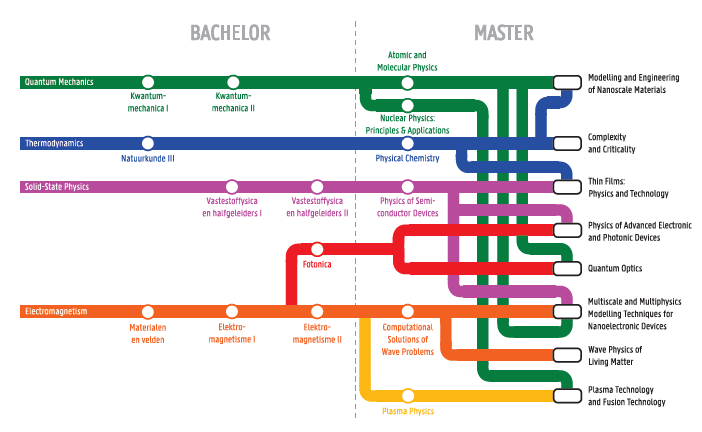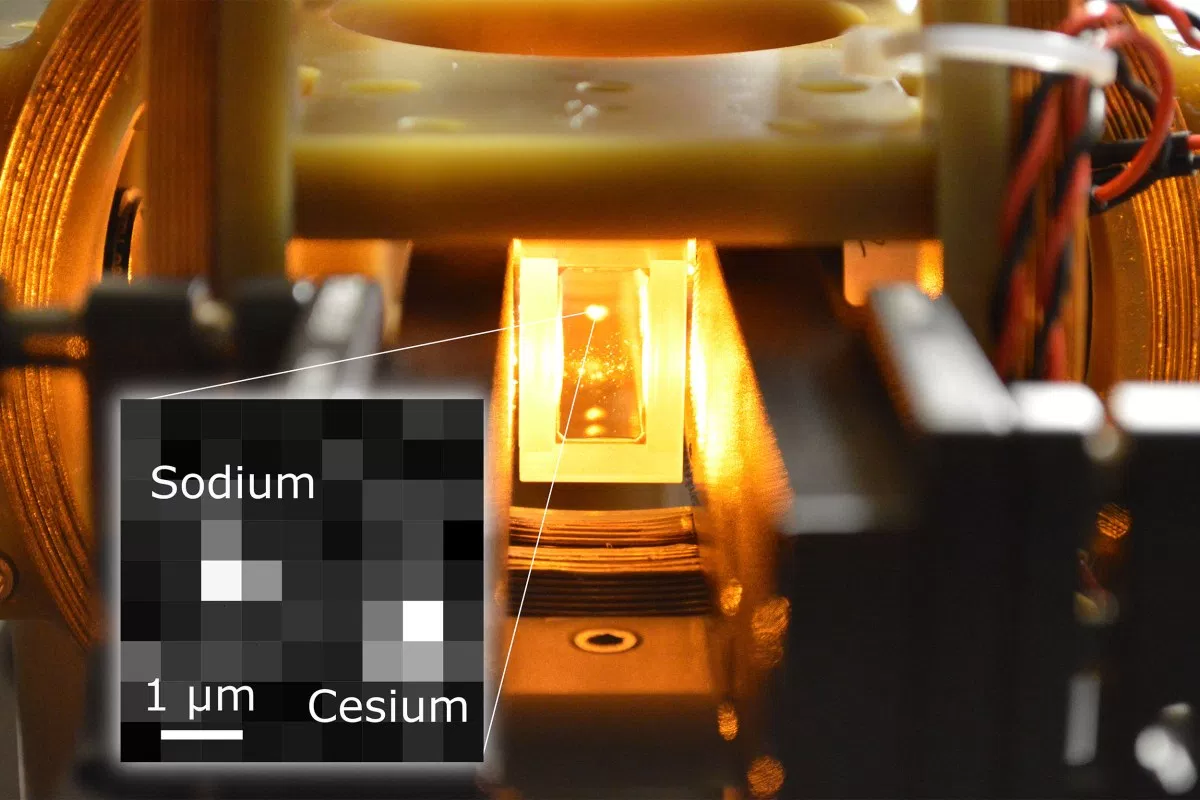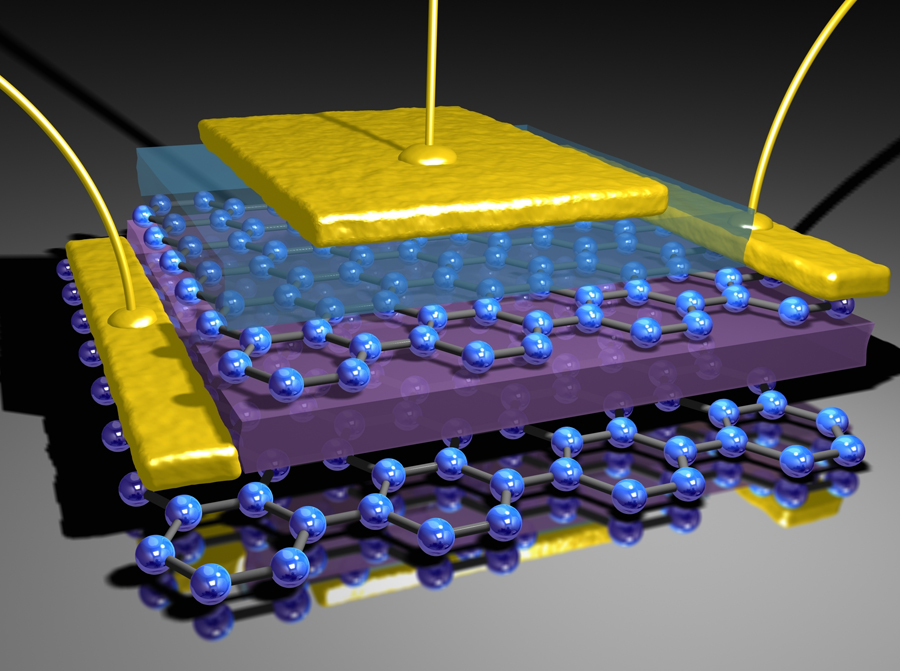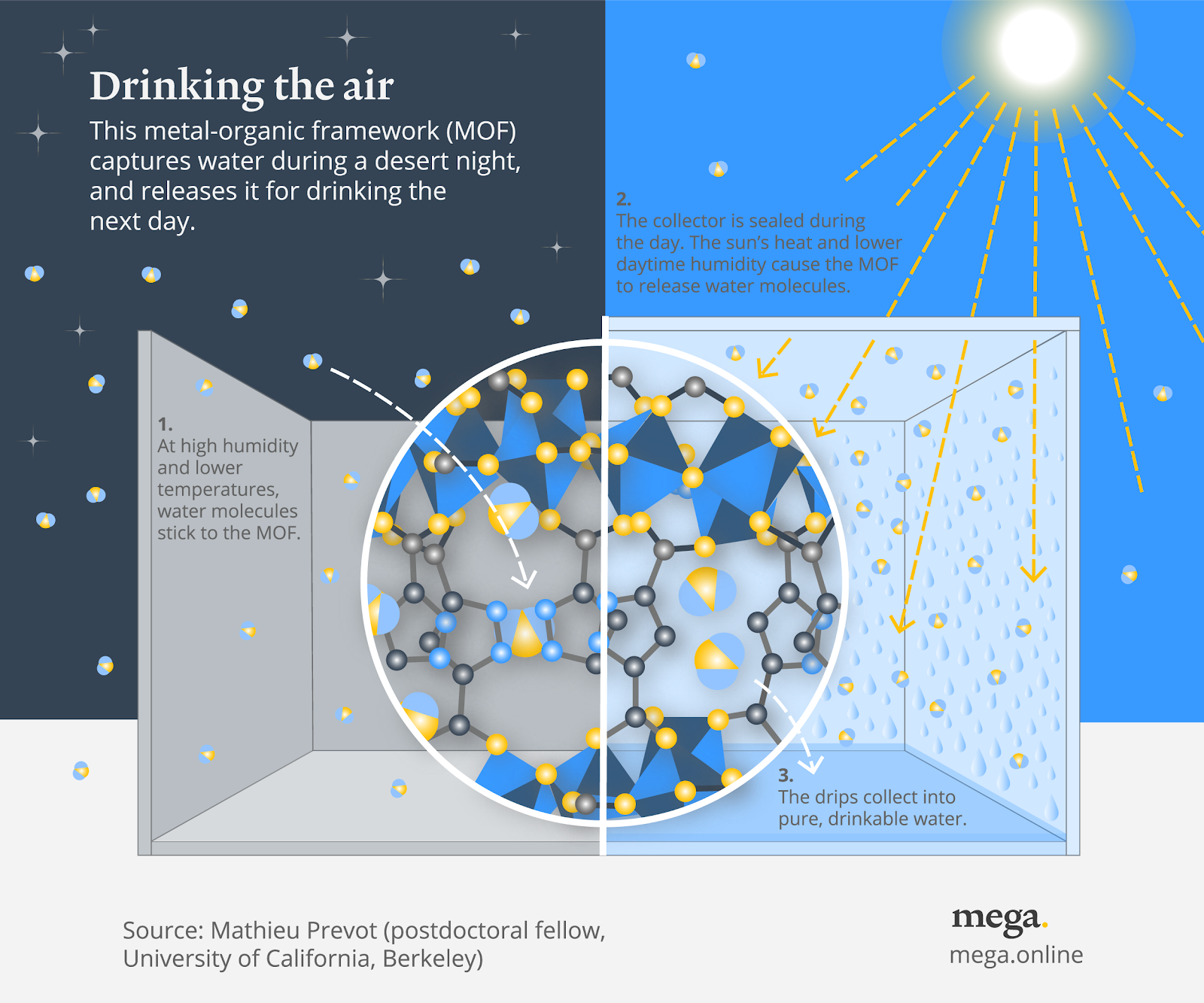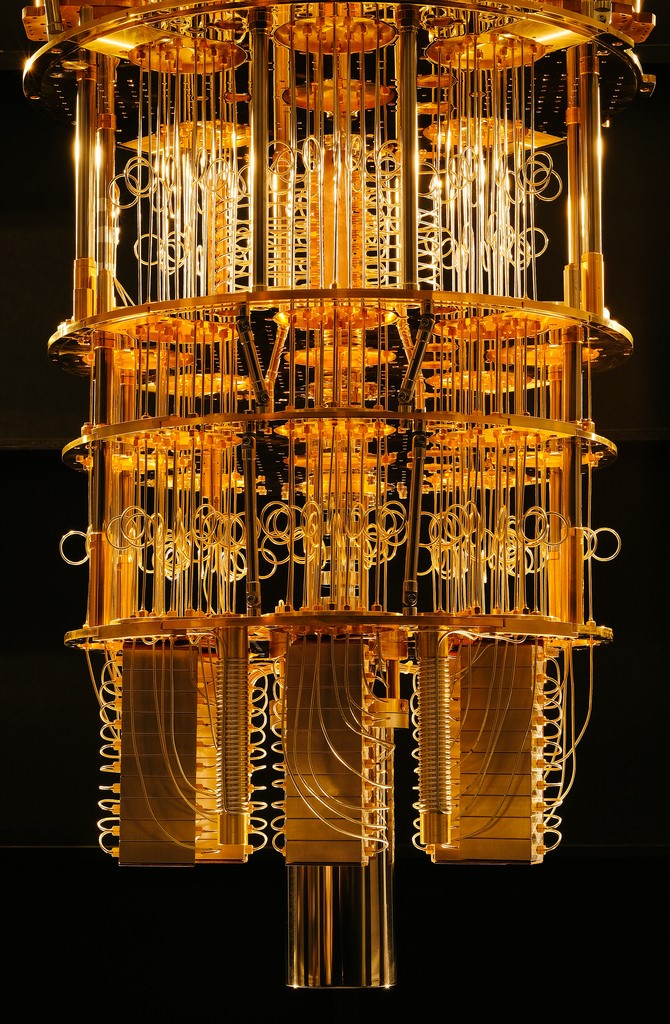Engineering Physics
Education in a nutshell
How to start this programme?
The natural path to the engineering physics education runs via a selection of courses in the second and third bachelor. Student can than enter the program well prepared.
However, if your interest in Engineering Physics emerges later in life, it is still possible to enter the master programme provided additional courses are followed by way of preparation. If you would consider the engineering physics master after completing another master (e.g. Electrical engineering of Physics and Astronomy), adapted programs that combine bachelor and master courses are available.
General
The engineering physics programme is unique in Flanders and combines an engineering perspective with a thorough physical background. It prepares the students for being at the forefront for development of the technologies of the future, hereby focusing on a longer time-perspective than other engineering disciplines. The Engineering Physics programme therefore is one of the most fundamental of all engineering studies due to its focus on state-of-the-art physical concepts and recent research developments.
Graduates of the study programme of the Bachelor and Master of Science in Engineering Physics are able to design engineering applications from the point of view of their most fundamental physics, allowing them to tackle challenges in some of the most exciting emerging technologies.
The programme is supported by research groups from both the Faculty of Engineering and Architecture and the Faculty of Sciences. Their classes highlight a broad variety of application domains, ranging from nanoscale materials and plasma technology to electromagnetic and integrated (opto-)electronic devices. Students are moreover able to determine the focus of your own master’s curriculum thanks to the possibility of choosing several elective courses.
Jobprofiles
Structure of the programme (common courses, learning paths, …)
Quantum mechanics
At very small length scales, the deterministic laws of classical physics break down and are replaced by the probabilistic ones of quantum mechanics. Taking into account quantum mechanical phenomena for engineering purposes is essential due to the increasing miniaturization of many technologies (e.g. nanoscale transistors, quantum dots) or to understand many light-based applications (e.g. lasers, spectroscopy).
Thermodynamics
Thermodynamics describes how different forms of energy are exchanged and balanced with one another. It is the most essential field of science to understand equilibria between different phases of matter, heat flow, or energy conversion efficiencies. As such, a good grasp of thermodynamics is vital to develop any engineering application related to energy or materials.
Solid-state physics
Many technological advances in the last 50 years are based on innovations in solid-state materials. It was only by understanding the fundamental operation of silicon, for example, that chips with electronic (e.g. transistors) and photonic devices (e.g. LEDs) could be designed. The development of advanced materials such as superconductors also heavily relies on a firm background in solid-state physics.
Electromagnetism
Electromagnetism is a broad area that relates to any phenomenon that is based on static or time-dependent electromagnetic fields. Visible light is a well-known example, but also radio waves or X-rays are indispensable in a wide range of applications (e.g. telecommunication). In addition, electromagnetic effects are important to understand the make-up of matter itself, as is the case for plasmas or liquid crystals.
Students 3rd bachelor about the online courses and the cross-course project
- Bachelor
The Bachelor programme aims to provide a thorough background in mathematics, physics, and engineering sciences. Besides some broad and generalist courses, shared by all engineering students, a number of important learning paths are developed. They not only elaborate on subjects in mathematics and classical mechanics, but also dig into the four areas of expertise essential to Engineering Physics: quantum mechanics, thermodynamics, solid-state physics, and electromagnetism (see [hyperlink to Learning paths]). These topics are then further built on for advanced applications in the Master.
The Bachelor programme in Engineering is designed to facilitate the transition from secondary to university education. The curriculum contains three important parts:
- Basic knowledge and skills in mathematics & science
- Engineering courses and a corresponding attitude
- Practical project classes
1st Bachelor
The first Bachelor mostly focuses on the first and third aspect: mathematics and sciences, and projects. Wherever possible, the courses are linked to engineering applications, but the main goal of the first year is to provide the necessary basis upon which (more advanced) engineering classes can be built.
The first Bachelor is common to all engineering programmes. Afterwards, you need to choose a particular study programme. “Toegepaste Natuurkunde” (Engineering Physics) is one of the seven possible Bachelors in Engineering, all of which are (mainly) taught in Dutch.
2nd Bachelor
The second Bachelor forms a bridge between the basic mathematical and scientific courses of the first Bachelor and the basic engineering courses of the third Bachelor. It hence does not only contain classes common to all engineering studies, but also a few introductory topics unique to the Engineering Physics programme. The latter courses are indicated in colour in the following table.
3rd Bachelor
The third Bachelor elaborates on applied physical aspects by means of a number of basic courses in physics and engineering. They aim to provide you with an overview of all key research domains of the programme. The Bachelor programme is completed by a Bachelor Dissertation (‘Vakoverschrijdend project’).
2. Master
The curriculum
The curriculum of the Master in Engineering Physics contains 8 mandatory courses (48 ECTS credits), all of them taught in the first Master. The rest of the first Master and the entire second Master are exclusively reserved for elective courses (some dedicated for the study programme, some social, and some free). The second Master also requires writing a Master Dissertation. Except for the free and social elective courses, all classes balance an engineering point of view (system analysis, design, and optimization) with a physics approach (experiments and mathematical modelling).
The mandatory classes build upon the learning paths that were established in the Bachelor and introduce a broad set of advanced technological applications that make up the focus of Engineering Physics. These applications are situated in the fields of energy, photonics, electronics, biomedical engineering, nanosensors and nanoactuators, and information technology. In addition, the mandatory classes provide the necessary background to follow specialized elective courses, which are strongly linked to the university’s research in the area of engineering physics. Finally, the mandatory courses include a project in close contact with industrial partners, which applies all of your engineering physics skills with a broader view on entrepreneurship, sustainability and societal value.
One of the main principles of the study programme is the ability to compose your personalized curriculum, following your own focus or interests. For this reason, the second Master entirely consists of elective courses. Five classes can be chosen from a shortlist of engineering physics key topics. They provide a detailed description in specialized subdomains. In addition, there are also 12 ECTS credits worth of free elective courses, which allow you to broaden your knowledge or to elaborate one particular expertise. These classes can be chosen freely from any Master’s programme of a beta faculty (Faculty of Engineering and Architecture, Faculty of Sciences, Faculty of Bioscience Engineering). The remaining six credits are reserved for elective courses that highlight the aspects of engineering in society, and are chosen from a faculty-wide list. Internships also belong to this category.
Some highlights
Application domains
Energy applications
Our society devours energy at an ever increasing pace. This not only requires an increasing number of energy resources (43% more by 2040), but also leads to higher CO2 emissions (35% more by 2040). To sustain our current standard of living in an environmentally friendly way, there is therefore an urgent need for innovative sources of energy. As a student in Engineering Physics, you are at the forefront of these evolutions thanks to your background in nuclear and particle physics (fission and fusion), atomic-scale materials science (hydrogen storage, batteries, superconductors), and semiconductor technology (solar cells).
Related key topics: “Plasma Technology and Fusion Technology”, “Physics of Advanced Electronic and Photonic Devices”, “Modelling and Engineering of Nanoscale Materials”, “Thin Films: Physics and Technology”
Related employers: Umicore (batteries, solar cells), FANC (fission), EUROfusion (fusion), Nexans (cables), OCAS (metals for energy applications), imec (solar cells), SCK.CEN (nuclear technology)
© ITER Organization, http://www.iter.org/
Application in the spotlight: Nuclear fusion is the opposite of traditional thermonuclear fission. Whereas classical fission reactors use neutrons to split heavy nuclei, fusion reactors combine light nuclei into heavier ones. Nuclear fusion promises an almost limitless supply of energy without CO2 emission and a minimum of radioactive waste. It is worked on by a worldwide collaboration, running on a multibillion budget (e.g. € 20 billion for ITER, the test reactor currently under construction in France). Successful development of nuclear fusion requires dealing with a number of interesting challenges, such as heating and magnetically containing the plasma, harnessing the immense amount of released energy and designing materials that are able to withstand high neutron fluxes and temperatures up to 900 °C.
Photonic applications
Photonics forms the technological basis for the conversion of sunlight into other forms of energy or electricity, for visualization purposes, and for the manipulation of matter. Recognized as one of the European Commission’s key enabling technologies, photonics plays a major role in the production of renewable energies and in the development of components such as photodiodes, LEDs, liquid crystal displays, and lasers. Photonic applications are therefore inherently multidisciplinary, with a strong connection to energy (solar cells), electronic (communication technology, displays), and biomedical applications (lasers, microscopy). Due to the continuous downscaling of photonic devices, a quantum mechanical description of photonic devices is crucial to fully understand and predict their performance. As a student in Engineering Physics, you possess the necessary skill set to meet these evolutions head on thanks to your background in photonics, quantum mechanics, and semiconductor technology.
Related key topics: “Physics of Advanced Electronic and Photonic Devices”, “Quantum Optics”
Related employers: Barco (displays), Esterline (displays), OIP (optics), Lambda X (optics), Luceda (optics, UGent spinoff), Indigo Diabetes (optics, UGent spinoff), imec (opto-electronics), Eyeco Eyeco (opto-electronics, UGent spinoff).
© IOP Publishing, https://physicsworld.com/a/optical-tweezers-create-a-single-molecule-from-two-atoms/
Application in the spotlight: Similar to conventional tweezers holding macroscopic objects, optical tweezers can be used to hold and manipulate objects as small as a single atom. Optical tweezers are very sensitive photonic devices that generate a highly focused laser beam able to detect and trap sub-micron particles in its path by exerting small forces on it (on the order of a few piconewtons). They are often used to manipulate and study single atoms and molecules. In the figure, optical tweezers are used to hold single sodium and cesium atoms before their combination into a single molecule, but also larger molecules such as DNA can be manipulated. Developing these optical tweezers poses challenges on both fundamental – how to reliably generate a well-defined laser beam – and practical levels – how to combine these beams into a microscope.
Electronic applications
As the world economy has evolved to a digital economy and the smartphone seems to have become a natural human extension, electronic devices are now indispensable for both the individual and society in general. More and more domestic electronic applications are systematically labelled “smart” as they become more advanced, with a further integration of the abilities that used to require separate devices. All devices are moreover expected to steadily increase in performance and speed, while getting more compact at the same time. As a student in Engineering Physics, you become acquainted with all the fundamental physics that make these devices thrive, ranging from electromagnetism over semiconductor technology to quantum mechanics for the smallest devices. Thanks to this fundamental understanding of the different applications, new challenges in the development of more advanced devices can be easily tackled.
Related key topics: “Physics of Advanced Electronic and Photonic Devices”, “Multiscale and Multiphysics Modelling Techniques for Nanoelectronic Devices”, “Modelling and Engineering of Nanoscale Materials”, “Thin Films: Physics and Technology”
Related employers: ON Semiconductor (production semiconductor devices), imec (research on electronic devices), Caeleste (CMOS), OIP (opto-electronics), Antwerp Space (satellite communication), QinetiQ Space (space instruments)
© Kurzweil Network, http://www.kurzweilai.net/multi-layer-3d-graphene-transistor-breakthrough-may-replace-silicon
Application in the spotlight: Given the insatiable need for more performant electronic devices, metal-oxide-semiconductor field-effect transistors (MOSFETs), the basic switching units in the integrated circuits of digital logic devices, have been systematically reduced in size to meet new performance standards. As MOSFET scaling is approaching its limits, new technological advances in the material and device concepts will be required to ensure a continued progress in the FET’s performance. One of the particularly interesting materials researched within this context is graphene. Since the discovery of the exceptional electric field effect exhibited by graphene, the graphene transistor has become a widely investigated electronic device. Especially the possibility of designing transistors with a channel that is just one atomic layer thick, makes them very attractive, along with the promising high speeds they can achieve, as already demonstrated experimentally. Issues regarding their ability to be switched off make up one of the remaining barriers to become fully competitive with the governing MOSFET technology.
Biomedical applications
Many recent advances in medicine are thanks to progress in physics and engineering. The increased understanding in elementary particle physics allowed for the construction of high-tech imaging equipment, such as X-ray tomography, electron-positron tomography (EPT), or nuclear magnetic resonance (NMR/MRI). In addition, several medical procedures are based on insights in plasma treatment, electromagnetic or acoustic stimulation, or the development of new biologically compatible materials. On the other hand, technology can have an undesired biological impact (noise pollution, electromagnetic stray fields). All of these aspects are ideally tackled by physical engineers.
Related key topics: “Wave Physics of Living Matter”, “Plasma Technology and Fusion Technology”
Related employers: Siemens (medical imaging), Philips (medical imaging, surgical devices), Cochlear (hearing aids), UZ Gent (device operation and monitoring)
Photo by Paweł Czerwiński on Unsplash
Application in the spotlight: We are in ever closer contact to electromagnetic radiation. Think of our constant exposure to signals from cell phone, GPS, or Wi-Fi, and broadcasts from radio and television, for example. This exposure is expected to increase even further, since the deployment of a 5G network will require installing additional antennas. There is moreover an omnipresent background “noise” due to high-voltage applications, which operate at a frequency near 50 Hz. It is currently not unambiguously clear how these various levels and frequencies of electromagnetic emissions affect the human body. Resolving that question necessitates advanced insight into the interaction between electromagnetic waves and matter.
Nanosensor and nanoactuator applications
Various aspects of modern life depend critically on the ability to detect specific signals and react correspondingly. The sensors in airbags, for example, detect sudden changes in acceleration by means of capacitance measurements and quickly release a propellant to inflate a fabric bag. In today’s society, however, it becomes increasingly crucial to be able to detect the smallest signals (e.g. minuscule amounts of highly toxic compounds) or to miniaturize a device capable of both sensing and acting (lab-on-a-chip). Therefore, scientists all over the world are developing new devices capable of sensing with an unseen sensitivity as well as acting with extreme precision by designing their composition and structure on the atomic scale. Because of these small length (and time) scales, an accurate description of the behaviour of such devices requires taking into account not only macroscopic solid-state properties, but also quantum mechanical phenomena (e.g. tunnelling).
Related key topics: “Modelling and Engineering of Nanoscale Materials”, “Multiscale and Multiphysics modelling techniques for nanoelectronic devices”, “Physics of advanced electronic and photonic devices”, “Complexity and criticality”, “Quantum optics”
Related employers: Verotech (consulting and engineering services for high-tech R&D projects), imec (nano-electronics for healthcare, smart cities, energy …), nanocyl (manufacturing carbon nanotubes)
Scientific American: https://www.scientificamerican.com/custom-media/pictet/a-material-to-save-the-world/
Application in the spotlight: For millions of people, access to drinkable water remains a formidable challenge. Researchers at UC Berkeley showed that they were able to capture and re-release water from the air using an advanced nanostructured material, a so-called metal-organic framework (MOF). MOFs are hybrid materials consisting of metal-oxide clusters connected by means of organic linking molecules. The resulting materials are crystalline, but they possess a large number of nanometer-sized holes, so-called nanopores. These pores allow the material to adsorb large amounts of various compounds, such as water, carbon dioxide, methane, or even certain chemical warfare agents. In the case of the MOF of UC Berkeley, the release of water occurs when the material senses sunlight, making it ideal for use in desert conditions. Metal-organic frameworks are also interesting for other applications, however. Some MOFs exhibit a large degree of flexibility, in which the material can shrink or expand as a response to a change in temperature, mechanical pressure, or the presence of specific gases. These features make MOFs highly promising materials for an even wider range of applications, e.g. nanodevices to store and release energy from mechanical shocks.
Information technology applications
Data have an ever increasing importance in today’s digital society. Information technology is used to treat this massive amount of information and transfer it as fast as possible, without loss of accuracy of the transmitted message. With a strong knowledge of electromagnetics (5G, antennas) and photonics (optical fibers), students in Engineering Physics can make a major contribution to this crucial area. In addition, the strong analytic insight and programming skills developed during the education can be used to analyze enormous amounts of information (big data analysis, artificial intelligence (AI)). Finally, physical engineers are also on the first row for the development of quantum computers, the next game-changing computers, thanks to their strong understanding of the quantum mechanical principles.
Related key topics: “Multiscale and Multiphysics modelling techniques for nanoelectronic devices”, “Physics of advanced electronic and photonic devices”, “Quantum optics”, “Complexity and Criticality”
Related employers: imec (digital technology), Nokia (telecommunication), IBM (computers and IT), Google (IT and digital technology), Open Analytics (data science), ML6 (artificial intelligence), radix.ai (artificial intelligence), RoboVision (artificial intelligence)
Scientific American: https://www.scientificamerican.com/article/is-the-u-s-lagging-in-the-quest-for-quantum-computing/
Application in the spotlight: The bits of classical computers can only be in two states: 0 or 1. Quantum computers use a fundamentally different kind of bit, the quantum bit (qubit), which allows for a superposition of the classical 0 and 1 states. Problems that are not feasible to solve using a classical computer, can be tackled in a reasonable time frame using a quantum computer, since multiple outcomes can be considered simultaneously. In order to build a working quantum computer at room temperature, the main challenge is to create stable qubits that can be processed without collapse of the superposition, which would make it nothing more than a classical bit. Also new quantum gates (the quantum version of a logical gate) need to be assembled. While waiting for the first commercially available quantum computer, new quantum algorithms are already on their way. These algorithms use the extraordinary behaviour of qubits to treat data several orders of magnitudes faster. This paves the way for a whole new branch of applications, such as quantum cryptography and more humanoid AI systems.
- Internship
In the study programme Engineering Physics, an internship is not mandatory, but you can take one or two as an elective social course. You can choose either an internship of 3 ECTS credits (Internship 1), two internships of six credits (Internship 1 and Internship 2) or one internship of six credits (Internship 3). This internship may take place at a domestic or foreign company, or at a foreign research centre (in the latter case you are asked to demonstrate that the internship is sufficiently oriented towards experience and a nonacademic profession).
You can find more information at the ‘Internship’ webpage of the Faculty (in Dutch):
http://www.ugent.be/ea/nl/onderwijs/stage
- Master dissertation
The Master Dissertation is closely related to the current scientific research of the engineering physics departments. Results often lead to contributions at conferences, or even to publications. In this respect, our study programme really gets the highest marks!
Several theses also contain an international dimension: short stays at foreign research institutes belong to the possibilities. Some Master Dissertations are even entirely performed abroad, at universities or research centres. This is not only the case for participants in a one-semester or one-year Erasmus programme; several past theses were written at research institutes like the Forschungszentrum Jülich (D), DESY Hamburg (D), Center for Advanced Radiation Technology (NL), ILL and ESRF Grenoble (F), Commissariat à l’énergie atomique et aux énergies alternatives (F), Natlab Philips Eindhoven (NL), ISOLDE-CERN (CH), Grand Accélérateur National d’Ions Lourds, Caen (F)...
- Erasmus
An Erasmus programme is possible in the first or the second Master, and can take one or two semesters. Although you can choose your particular Erasmus curriculum with a promoter or the Erasmus coordinator, it is essential that your choices maintain the Engineering Physics philosophy. This means that you still have to take all mandatory courses of the Master’s programme and five elective courses from the list of ‘key topics’. You can follow these classes at Ghent University, or (in an equivalent form) abroad during your Erasmus stay. Take this into account when planning your Erasmus programme (especially when you’re abroad during your first Master). It is moreover necessary to discuss the equivalence of certain courses with the Erasmus responsible of Engineering Physics and the chairperson of the Study Programme Committee.
Ghent University has a nice webpage about Erasmus programmes: https://www.ugent.be/student/nl/studeren/naar-buitenland/erasmus/erasmus.htm.
Much information can also be found on the website of the Faculty: https://www.ugent.be/ea/nl/faculteit/uitwisseling/internationalisering.htm
- External intake
The Bachelor in Engineering Physics is not the only way to start a Master in Engineering Physics. Other study programmes give access to it as well. To compensate for the difference in background knowledge, a bridging or preparatory programme is required. In some cases, a few courses suffice, which can be combined with the Master programme into a modified 2-year Master, while other cases require you to follow a full 90 ECTS preparatory programme.
A modified 2-year Master in Engineering Physics is available to four other Masters:
- Master of Physics
- Master of Physics and Astronomy
- Master of Electrical Engineering
- Master of Photonics Engineering
For some other studies, a preparatory programme is required:
- Bachelor of Science in Engineering with another main subject than Engineering Physics (Toegepaste Natuurkunde)
- Bachelor of Physics, Bachelor of Physics and Astronomy
- Master of Science in Industrial Sciences
If your preliminary training is not listed above, it may be possible to compose an individual programme. Contact studietrajectplateau.ea@ugent.be and provide them with the necessary information about your previous education (exam records).
The preparatory programme contains a fixed part of 30 ECTS credits and a variable part of 0 to 60 ECTS credits. The entire preparatory programme hence amounts to 30 to 90 ECTS credits, depending on your preliminary training. It is moreover possible to receive an exemption for some course units in the ensuing Master (see https://www.ugent.be/ea/en/for-degree-students/your-studies-in-ghent/paq.htm). This depends on your particular background.
Research framework of the study program
Engineering physics is strongly grounded in research. During the master years specifically theory, labs, projects, and master dissertations are strongly related to the research of the participating research groups. This assures that the education is dynamic and timely and trains the students to become creative researchers as well as innovating engineers.
Links to some of the participating research group’s websites can be found here:
https://www.ugent.be/ea/appliedphysics/en/research/plasma
http://www.photonics.intec.ugent.be/
Many of our alumni continue their education by doing a PhD both in the labs at UGent and abroad. In both cases, their work is truly international, collaborative, and multidisciplinary. They benefit from the internationally connected research teams at UGent.
See one of our PhD students at work during the PhD-cup finals
More information
Brochure Bachelor Burgelijk Ingenieur (Dutch)
Brochure master of science in engineering physics
Studiekiezer 'Bachelor of Science in de ingenieurswetenschappen (toegepaste natuurkunde)
Studiekiezer 'Master of Science in Engineering Physics'
